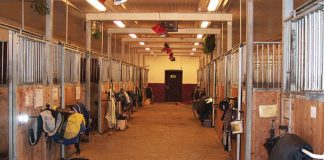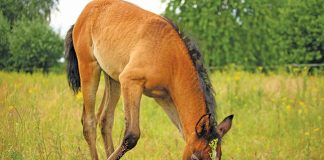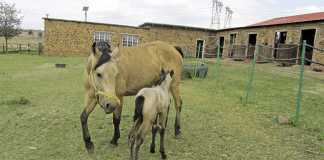The equine stifle joint links the femur, tibia and patella (kneecap) in a horse’s hind leg. It consists of three compartments and 14 ligaments.
Fluid within each of the three joint capsules lubricates the movement of the stifle joint. As the joint flexes and straightens, the ligaments keep the bones of the stifle aligned.
Inside the joint, the femur is divided into two parts called condyles; each has a hard cartilage cap – the meniscus. The patella, which is in front of the stifle, is joined to the femur and tibia by ligaments.
One of the main causes of stifle lameness is a locked patella or delayed patellar release. The patella ‘freezes’ over the inner condyle and the hind leg points backwards because the horse cannot straighten it. This may be due to an imbalance of minerals after weaning – when a foal no longer gets an ideal ratio of calcium and phosphate from its mother’s milk.
Ideally, each hind leg should follow a straight line from the pelvis to the ground when seen from behind. If a joint is crooked, the weight bearing on the joints is uneven.
Delayed patellar release can also occur when overweight or unfit horses are brought back into work suddenly, as the thigh muscles play a role in stabilising the joint.
The second cause of stifle lameness is injury. This is common in horses that turn at speed or travel fast over uneven ground. The problem may be hereditary; check the bloodlines if you are breeding performance horses.
The third cause of stifle lameness is chronic arthritis in an old horse.
A locked patella can be treated by improving mineral balance and using systematic training to build up thigh muscles. Alternatively, it can be treated surgically by scarifying the medial patellar ligament.
Sprains
If the stifle is sprained, the vet may prescribe liniment rubbed around the joint, anti-inflammatory drugs and limited exercise.
Here, you can lead the horse at a walk in straight lines for 10 minutes at a time, three to four times a day. Gradually build up to walking for 20 to 30 minutes. Lunging is not advised, as moving in a circle puts more strain on the stifle.
If you can, call in an equine physiotherapist to assist with stretching. A beamer can be used on the other hindquarter muscles as well as the affected joint.
Severe stifle injuries require urgent veterinary attention and follow-up after diagnosis using X-rays, sonars or arthroscopy. The vet may take samples of joint fluid to check for inflammatory cells.
Your vet might recommend an injection into the joint of corticosteroids, hyaluronic acid or polysulfated glycosaminoglycan.
With severe injuries, surgery might be needed to remove bone chips or parts of a damaged meniscus. In horses with chronic arthritis, supplements containing methylsulfonylmethane, glucosamine and chondroiten are helpful. During winter, you can massage liniment into the stifle area.
Under the direction of a vet, you can also add anti-inflammatory medications to your horse’s feed.
Dr Mac is an academic, a practising equine veterinarian and a stud owner.













